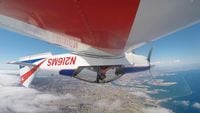I have a handful of things I like doing in my life. Riding motorcycles and flying planes are near the top of the list, for a few reasons—not least of which is the sense of accomplishment I feel when I get it right. Nothing matches the feeling of all of the puzzle pieces coming together: experience, technique, and practice combining to create the feeling of flying, sweeping through the atmosphere, to the exit of a corner. I’ve never experienced anything so close to the feeling of flight as carving a canyon on a motorcycle, and for a fraction of the cost.
I get that same feeling when I fly a plane on a windy day and pull off a buttery smooth landing or when I fly a perfect loop and feel the thump when the plane passes through its own turbulence, ending the maneuver at the exact same point in the sky. Riding a motorcycle has a lot in common with flying an airplane (certainly much more so than with driving a car), and I think it’s the complexities that make it satisfying.
Most actions in a car have one output for each input by the driver. Stomp on the gas pedal, you accelerate; hit the brakes, you slow down. Basically. Airplanes are more complex. When you slam the throttle forward on your high-performance Extra EA-300 (think BMW S1000RR with wings), the airplane accelerates forward, the nose pitches up into a climb, and the airplane starts to roll to the left (Google "P-factor" if you're curious). That's one input by the pilot with multiple outputs by the plane.
There are lots of examples of this, and a motorcycle shares the complexity. Grabbing the front brake in a corner changes the speed of the machine, which changes the arc of the turn, and the suspension load changes chassis geometry, often making the bike want to stand up mid-corner. Snapping the throttle open while rolling out of a corner makes the bike accelerate, lift the front wheel, and veer to one side. Again, one input with multiple outputs, all of which need to be managed. These challenges make riding motorcycles and flying airplanes harder to learn but even more rewarding when you finally get it right.
With modern electronics, the complexities can be subdued. Wheelie control keeps the front wheel on the ground, and electronic suspension can help prevent front-end dive. The same goes for a plane. Electronics can keep the nose level and counter roll and yaw when the pilot throttles up, but does it make the experience better?
As people learning to control machines for our own enjoyment, isn’t it better that we know what actually happens when a command is input? Shouldn’t we know what the dynamic of the vehicle is that we’re trying to control? Modern ABS allows a rider to grab a handful of front brake in a corner and not tuck the front, avoiding the lowside that would inevitably occur without electronics. But what are the limitations of the rider if they only learn how to ride with that safety net? What happens when they ride another bike and don’t have the fundamental understanding of braking technique in an emergency or smooth throttle control in a corner?
Electronic aids help us ride and fly more smoothly and safely than we have before, but they should be a privilege received from experience. Because, really, it is that experience and only that experience that allows a rider (or pilot) to truly appreciate their contribution to control. Yes, the learning is a struggle, but when all the pieces come together and you feel like you’re flying, you’ll enjoy it that much more knowing you earned it.










/cloudfront-us-east-1.images.arcpublishing.com/octane/3IVMYCZAHGVZKRIDA6FU7KOOHU.jpg)



/cloudfront-us-east-1.images.arcpublishing.com/octane/MUQLOVLL2ZDGFH25ILABNBXKTI.jpg)
/cloudfront-us-east-1.images.arcpublishing.com/octane/TNOU5DNE2BC57MFPMGN2EIDXAM.jpg)
/cloudfront-us-east-1.images.arcpublishing.com/octane/GTCXACQGJ5HAPDTGWUQKDEH44E.jpg)
/cloudfront-us-east-1.images.arcpublishing.com/octane/S35YGSEMEZB4BLTDJTSZPF4GLA.jpg)
/cloudfront-us-east-1.images.arcpublishing.com/octane/5UOT6HPX2JFMRJAX6EH45AR4MQ.jpg)
/cloudfront-us-east-1.images.arcpublishing.com/octane/OKWOJWAKP5EP3OACCRRWPCIX2Q.jpg)
/cloudfront-us-east-1.images.arcpublishing.com/octane/2WF3SCE3NFBQXLDNJM7KMXA45E.jpg)
/cloudfront-us-east-1.images.arcpublishing.com/octane/G4MG6OUCJNBSHIS2MVVOTPX65E.jpg)
/cloudfront-us-east-1.images.arcpublishing.com/octane/IIGGWFOTOJGB7DB6DGBXCCMTDY.jpg)
/cloudfront-us-east-1.images.arcpublishing.com/octane/QSTCM6AVEZA5JJBUXNIQ3DSOF4.jpg)
/cloudfront-us-east-1.images.arcpublishing.com/octane/U4I7G625B5DMLF2DVIJDFZVV6M.jpg)
/cloudfront-us-east-1.images.arcpublishing.com/octane/B6XD6LS6IVCQPIU6HXDJSM3FHY.jpg)
/cloudfront-us-east-1.images.arcpublishing.com/octane/ICL63FEDDRDTTMINYICCEYGMDA.jpg)
/cloudfront-us-east-1.images.arcpublishing.com/octane/FCGZHQXRBZFLBAPC5SDIQLVF4I.jpg)
/cloudfront-us-east-1.images.arcpublishing.com/octane/WNOB6LDOIFFHJKPSVIWDYUGOPM.jpg)

/cloudfront-us-east-1.images.arcpublishing.com/octane/X33NU3E525ECRHXLNUJN2FTRKI.jpg)
/cloudfront-us-east-1.images.arcpublishing.com/octane/6KKT5NNL2JAVBOXMZYS5ZO76YA.jpg)
/cloudfront-us-east-1.images.arcpublishing.com/octane/J5RKG5O455GMPGQRF2OG6LRT7A.jpg)
/cloudfront-us-east-1.images.arcpublishing.com/octane/GX2CIZKQVRH2TATDM26KFG2DAE.jpg)
/cloudfront-us-east-1.images.arcpublishing.com/octane/ZWIDYSAKQZHD5BHREMQILXJCGM.jpg)
/cloudfront-us-east-1.images.arcpublishing.com/octane/CYUHJZCTSJCH3MRAQEIKXK7SCQ.jpg)
/cloudfront-us-east-1.images.arcpublishing.com/octane/LKOFINY56FCXJCANJ5M7ZDQUBY.jpg)
/cloudfront-us-east-1.images.arcpublishing.com/octane/4NBPDACMWJH63JQYJVK3QRBDZI.jpg)